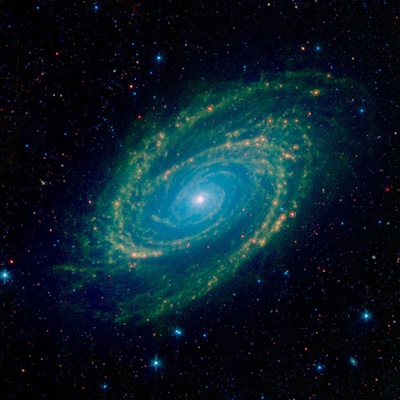M81 Galaxy Infrared Perspective
Located in the northern constellation of Ursa Major, which also includes the Big Dipper, nearby galaxy Messier 81 is easily visible through binoculars or a small telescope. M81 is located at a distance of 12 million light-years.
This Spitzer infrared image is a composite mosaic combining data from the Infrared Array Camera (IRAC) at wavelengths of 3.6/4.5 microns (blue/cyan) and 8 microns (green) with data from the Multiband Imaging Photometer (MIPS) at 24 microns (red).
Infrared radiation, also known as “IR,” is just one type of radiation that exists within the electromagnetic spectrum. The radiation that is used in microwave ovens is a type of radiation that has a place on the electromagnetic spectrum, while the radiation that is used in hospitals to create X-ray images is another. The light rays that allow humans to see the world around them and the radio waves that are used to deliver news and music are also types of radiation that exist within the electromagnetic spectrum.
Infrared radiation is so named because the wavelength of infrared rays is just a bit longer than that of red rays. The only types of radiation that humans can detect are light rays. If humans could see infrared rays on the color spectrum, it would appear just after or below red. The Latin infra translates to “below”.
Infrared radiation is an incredibly important part of every human being’s life. This is because IR is quite literally heat. Although human eyes cannot visibly detect IR, they can surely feel it. Wrapping a hand around a cup of hot chocolate, take a walk in balmy weather, or enjoy sizzling fajitas; in all of these experiences are interacting directly with IR. The 3.6-micron near-infrared data (blue) traces the distribution of stars, although the Spitzer image is virtually unaffected by obscuring dust and reveals a very smooth stellar mass distribution, with the spiral arms relatively subdued.
As one moves to longer wavelengths, the spiral arms become the dominant feature of the galaxy. The 8-micron emission (green) is dominated by infrared light radiated by hot dust that has been heated by nearby luminous stars. Dust in the galaxy is bathed by ultraviolet and visible light from nearby stars. Upon absorbing an ultraviolet or visible-light photon, a dust grain is heated and re-emits the energy at longer infrared wavelengths. The dust particles are composed of silicates (chemically similar to beach sand), carbonaceous grains and polycyclic aromatic hydrocarbons and trace the gas distribution in the galaxy. The well-mixed gas (which is best detected at radio wavelengths) and dust provide a reservoir of raw materials for future star formation.
Image Credit: NASA/JPL-Caltech







No comments:
Post a Comment